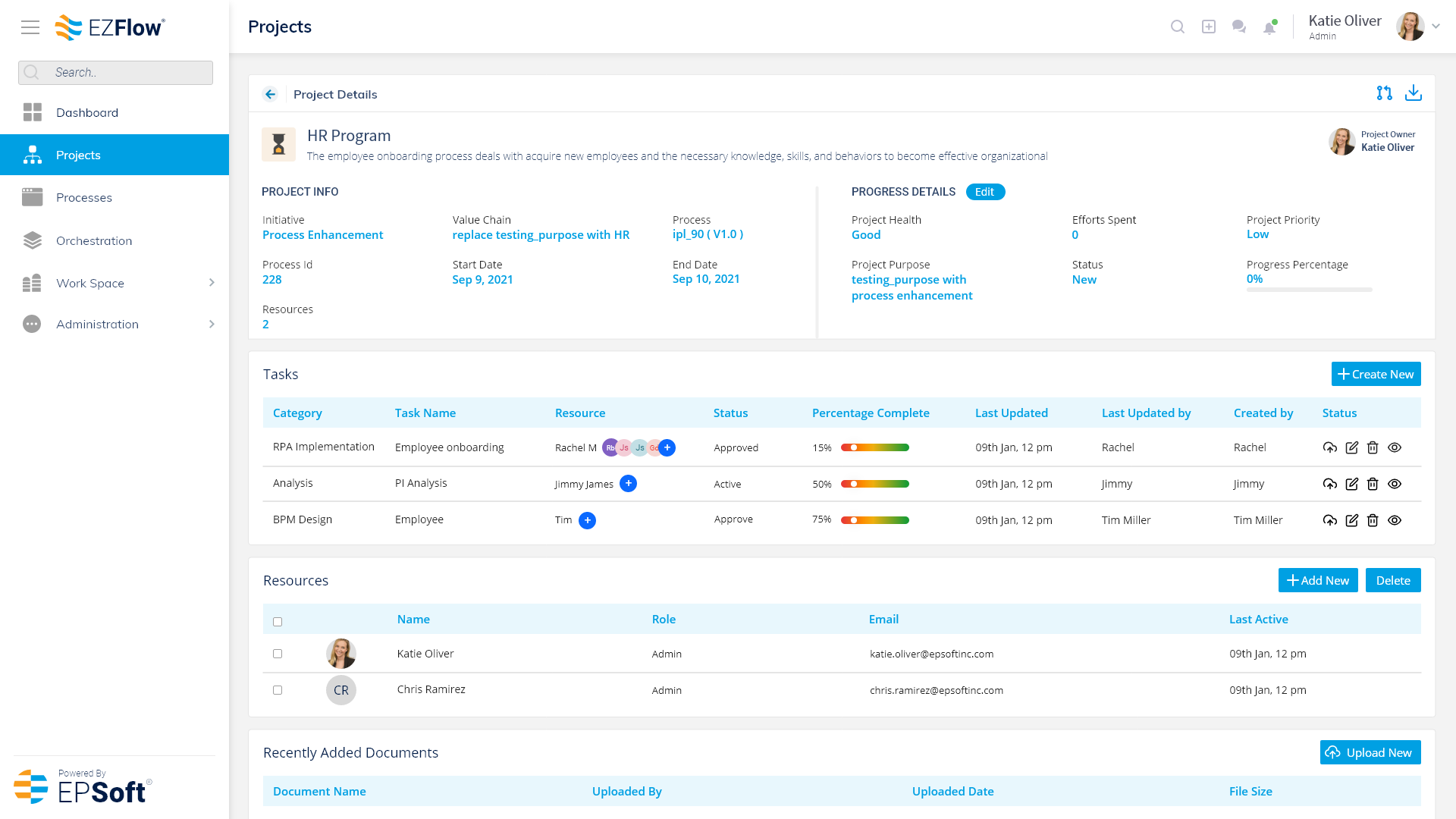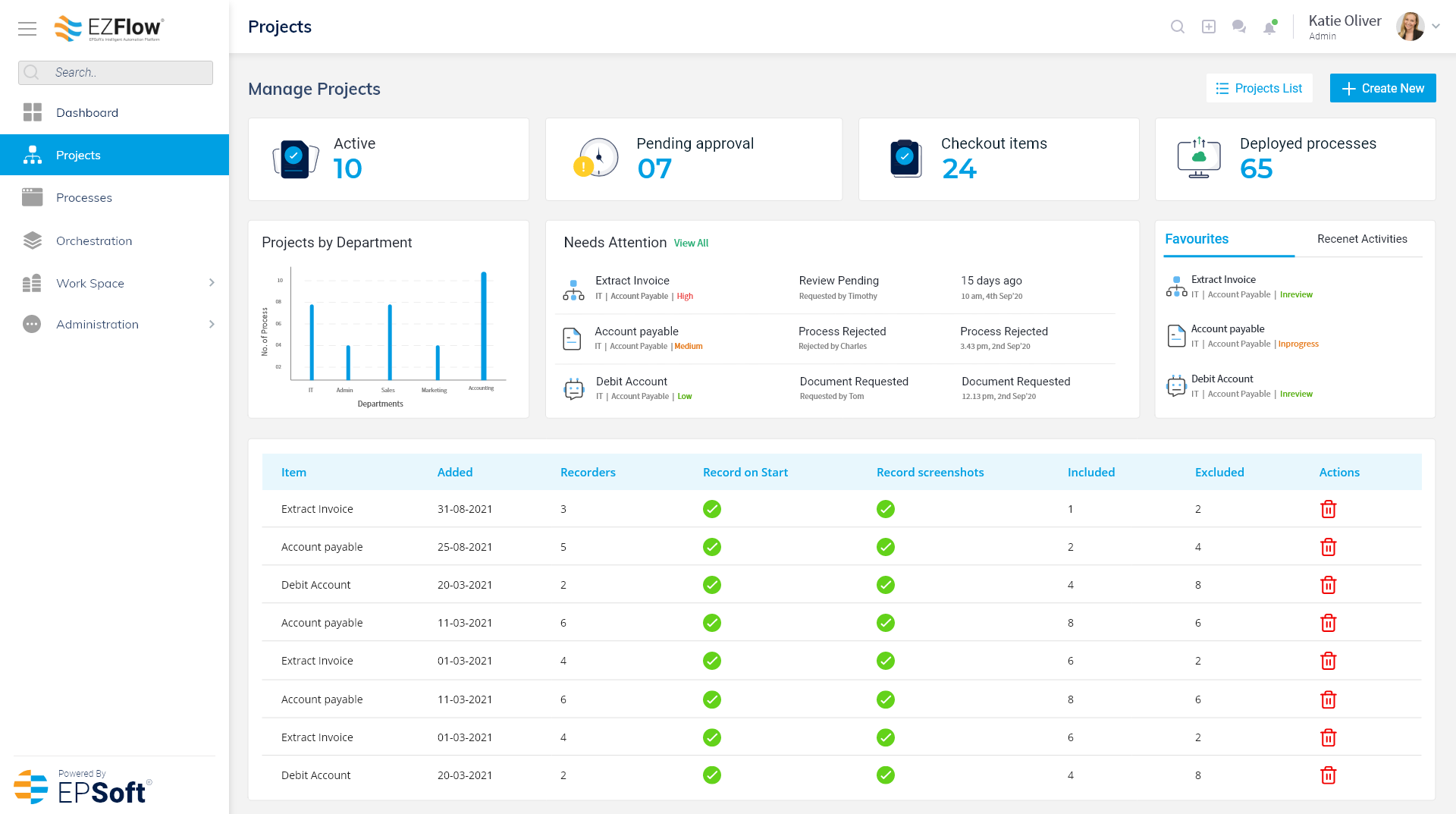Governance
Project Management and Process Automation
Governance is the key to decision making, strategic planning, cost control and risk management. Once your roadmap is in place, governance outlines a framework for risk management, and provides a clear and uniformed way for everyone to work across technologies. From here, you support the framework with programs and strategic objectives, which are then facilitated by project management, which is organized and executed by processes. Understanding the dynamics of programs, projects and processes is the key to proper governance.
A Value-Led Approach to Project Management
In addition to providing full visibility within a controlled environment, effective project management offers an opportunity for goal alignment. Every task is tied to a project and every project is tied to a goal, and each of these goals should always ladder up to the organization’s programs and strategic goals.
In this way, project management is the vehicle for ensuring every process automation initiative delivers the value it is intended to. A project-encapsulated change environment creates direction, control and purpose.

Project or Program?
When it comes to business process management, it’s important to understand the terms program and project. Program is a larger umbrella term that refers to a common goal for multiple projects within a portfolio.
A project, on the other hand, can represent one segment of a program. A program has a longer life cycle compared to a project, and the change impact is seen across multiple processes.
Project
- Shorter life cycle
- Can create multiple tasks within a project
- Change typically impacts a single process
- Engagement of Process Architect
Program
- Longer life cycle
- Can create multiple projects within a program
- Change impacts multiple processes
- Engagement of Enterprise Architect
Growth Through Governance
Improve collaboration and get more out of every automation with process governance and centralized project management from EZFlow that keeps everyone on the same page. Securely and easily connect everyone involved, identify key responsibilities, and seamlessly manage collaboration across all stages of the project—all in one place.

Organized Collaboration
The goals of the organization are supported by a controlled environment, thanks to a structure that starts with strategy, then outlines goals, then programs, projects, and all the people and technology levered within them.

Better Control
With automations running and multiple teams collaborating in the EZFlow platform, project management provides critical transparency and accountability, ensuring ongoing process changes are implemented in a cohesive, organized way.

A Roadmap for Success
Governance also gives us clear guidance on the best available tools for any given program or project, and how they should be used. This should extend to individual automations as well as any testing and required maintenance.

Data-based Decisions
As you tie each project to a program, and each program back to the governance structure within EZFlow, you gain a clear trail of data along the way, helping you understand what’s working, what’s not, and where—and why—to make improvements.
How Does EZFlow Help With Project Management?
EZFlow is specifically designed to help you initiate projects in a collaborative environment, realizing more value more quickly with each implementation. Providing an organized document repository, historical change logs, single pane visibility and more, EZFlow provides a seamless way to collaborate across all your project management initiatives.
Initiating a Project With EZFlow
Identify process changes in your project. There are generally three types of changes.
-
People
Whether you’ve solicited ideas or they’ve been volunteered to you, it is valuable to have suggestions on how to best improve a process from the people who are actively involved in it. Their experience is often detailed and well understood, and they provide a useful source of expert analysis.
-
Strategic and Goal-Driven Change
As companies grow and strategies mature, evolution takes place across the organization. This goal-driven strategic change typically involves large-scale, multi-touchpoint processes and involves enterprise and process architects.
-
Immediate Changes
Sometimes business needs require new changes. These standalone changes are for individual needs and can generally be implemented right away. These kinds of changes do not typically require comprehensive project management.
Initiate the project.
- Create the project pipeline and backlog. This list of changes will come from step 1. Decisions about prioritizations can be made offline, but all other decisions related to the changes are recorded with supporting documentation when necessary, attached to the project entry in the system.
- Per your prioritization, assign ownership and set the status to NEW.
Finalize and move to the process value chain.
- Once these changes are completed, the project is too, and it can be officially moved to the process value chain. The purpose of a project is defined with a clear scope confined to the changes that need to be made.
- Once that happens, the project ends there.
EZFlow Features and Benefits for Project Management
- Easily coordinate stakeholders and automation initiatives
- Simple structure for process governance
- Seamless and transparent management across all project phases
- Simplified prioritization of project initiatives
- Project can be easily tied to top-level strategic initiatives (programs)
- Historical logs for transparency
- Document repository for collaboration
- Simplified request management with approval and denial workflows
- Single pane view for easy management
- Data to help leadership make evidence-based decisions
Roles Involved in Project Management
Several key stakeholders should be instituted to ensure your project’s viability. Here’s a look at some common project management roles and responsibilities.

-
Process Owner (Executive Sponsor)
This main project stakeholder is accountable for detecting inefficiencies in the process and for improving it. This person also plays the role of a project sponsor, ensuring that the change goals of this project align with strategic company goals, and that there are clearly defined expectations of the change outcome. The process owner plays a key role in collaboration with other process participants. This role is responsible for keeping track of progress (as opposed to expenses) as well as evaluating the effectiveness of change post-completion.
-
Project Manager
This role can be fulfilled by a number of specific people, including the process architect or the enterprise architect. The project manager is responsible for the project from initiation to project closure. This person owns the entirety of the project details, performing initial analysis and adding project participants as required.
-
Process Architect
The process architect designs changes to the process and owns these project details. This person possesses a detailed understanding of the project and all its details and is typically involved at the process level.
-
Enterprise Architect
The enterprise architect approves the process architect’s designs. This person possesses a detailed understanding of enterprise level process architecture and is typically involved at the program level.
Getting Started with Governance and Project Management
From aligning project goals with broader strategic initiatives to assigning stakeholders and mapping out your implementations, there can be a lot to think about for project management. The good news is that EZFlow makes all of these things easier by design. If you’re ready to dive into project management and process design, reach out to schedule your free EZFlow demo.
- Brings stakeholders, automation projects and stakeholders together
- Process governance
- Management all the phases of a project seamlessly and transparently
- Keep track of and prioritize automation initiatives across the organization
- Each project can be tied to a program (a top-level strategic initiative)
- Tie projects to strategic initiatives and make evidence-based decisions
Getting Started with Process Intelligence
Ready to learn more? Let’s talk about how process intelligence by
EPSoft can transform your organization.




